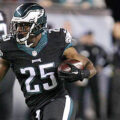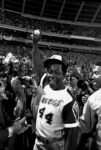ABOVE PHOTO: LeSean McCoy hopes to get more carries in Sunday’s game against the New York Giants.
(Photo by Webster Riddick)
By Chris Murray
For the Chris Murray Report
While the rest of the world focused on the horrific call threatened Monday’s Green Bay Packers-Seattle Seahawks game, there was something else that people, Eagles fans in particular should have also been focused on.
That would be the number of times All-Pro quarterback Aaron Rogers was sacked by the Seahawks defense, when it was eight. The pass-run ratio (39 passes, 21 runs) was enough to convince the Seahawks to pin their ears back and send folk flying at the quarterback. The Packers offense struggled to get the one touchdown they did get in the game.
If you’re an Eagles fan during the Andy Reid era in Philadelphia, Monday’s game was extremely familiar to you because you’ve been seeing it here in your own backyard for 14 years.
No matter how much folks want to blame Michael Vick for his lack of pre-snap reads, says he holds the ball too long or that he commits too many turnovers, we can’t deny the fact that when you pass all the time and the defense knows it, your quarterback is going to be in harm’s way whether it’s Vick, Tom Brady, Peyton Manning, or Rogers.
“That’s the key, you want to make an offense one dimensional so you can get after them,” said Eagles middle linebacker DeMeco Ryans. “If you know they’re going to throw the ball, you can definitely come after them and get more pressure on them. When you shut the run down completely, you put the ball in the quarterback’s hand and you can beat him.”
If that quarterback is working behind an offensive line that doesn’t have a lot of experience and you don’t want to give the ball to your best running back to slow the defense down, what you saw Monday night in Seattle and Sunday afternoon in Arizona is going to happen more often than naught. That’s not just on the quarterback, it’s on the coaching staff.
“Anytime you get the running game established in any offense, it keeps the defense guessing whether it’s a play-fake or a screen,” Running back LeSean McCoy said. “You have to keep those guys guessing.”
For all this nonsense that the NFL has become a passing league, you still have to run the ball enough to wear the defense down and give them something else to think about as they’re charging up field.
You would think after 14 years and three games into the 2012 season that Reid would assess his current situation and do something to protect his injury-prone quarterback and keep his offense on the field in the game itself rather than spending his post-game or day after press conferences saying. “my bad.”
When the Eagles beat the Baltimore Ravens, they put the ball in the hands of LeSean McCoy and Bryce Brown and ran more than they passed. There was a lot more rhythm in the offense because any defensive player will you tell a hard-charging running back and a 300-pound offensive lineman will slow down a defense and make them think—even if the team is 60-40 or 70-30 pass versus run.
“If a team is running the ball on you, it’s the start of a long day,” Ryans said. “You have to stop the run.”
What’s maddening about all this is that when Reid and the Eagles have effectively mixed in the running game, they’ve actually won more than they have lost. In 2008, after Donovan McNabb was benched in Baltimore, the Eagles utilized Brian Westbrook more than they had been in their offensive attack in the final six games of the regular season, they won five out of six and almost went to the Super Bowl.
“Listen, you’re seeing it with some of the good throwing teams in this league,” Reid said. “Balance, you’ve got to have some sort of balance, whether that’s 60-40, 70-30. You’ve got to be able to obviously keep defenses off balance to get yourself in a rhythm on offense.”
Okay, coach, we’re going to hold you do that on Sunday night against the New York Giants.
















Leave a Comment